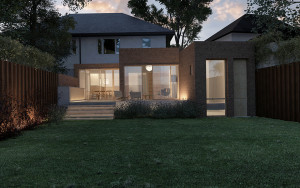An extension or addition to your home is something that you can do under ‘Permitted Development Rights’ (PDR), meaning that you do not need to apply for planning permission to undertake the work (see the general introduction to PDR in our last post). There are, however, certain limits and conditions that you need to be aware of and we cover some of those in this post.
For all types of extension, no more than 50% of the area of land around the ‘original house’ can be covered by the addition (bear in mind that ‘original house’ means the house as it was first built, or as it stood on 1 July 1948, if it was built before then). You will need to check whether a previous owner added an extension as this is included in the calculation, as are sheds and any other outbuildings.
Single-storey extensions
For single-storey extensions, if the project is completed by 30 May 2019, the rear wall of a detached home can be extended by up eight metres. If you live in a semi-detached or terraced house, this is reduced to six metres. These upper limits have been temporarily increased and if you extend more than four metres beyond the rear wall (detached) or three metres (semi-detached/terraced), you will need to go through the Neighbour Consultation Scheme to notify the local planning authority of your intention to use PDR in this case.
Under PDR, the extension must not be to the front or side of the building (if it is, it requires planning permission). The materials used in the extension should be similar in appearance to those on the exterior of the rest of the house, and the extension must not exceed four metres in height.
Double-storey extensions
For higher extensions of more than one storey, the addition can be no higher than the existing house and it may not extend more than three metres beyond the rear wall. You will also need seven metres between any boundary opposite the rear wall of the house. As with single-storey extensions under PDR, the materials you use must be similar to the existing house, and there are some additional rules about upper floor/roof windows.
Other points to bear in mind
The permitted development allowances that we have described in this post apply to houses in England only. If you are seeking to alter or extend a flat/maisonette, a converted house (or a house created through the PDR to change use), other buildings, or your house is in an area where there may be a planning condition (e.g. protected/designated area), you will need to check separate guidance and rules with your local authority. Some local authorities are able to confirm in writing (for a small fee) whether or not a planning application is necessary. Most extensions still require approval under Building Regulations.
You can read more detailed guidance on the Department for Communities and Local Government Planning Portal, or contact us for advice about a project you are considering.

